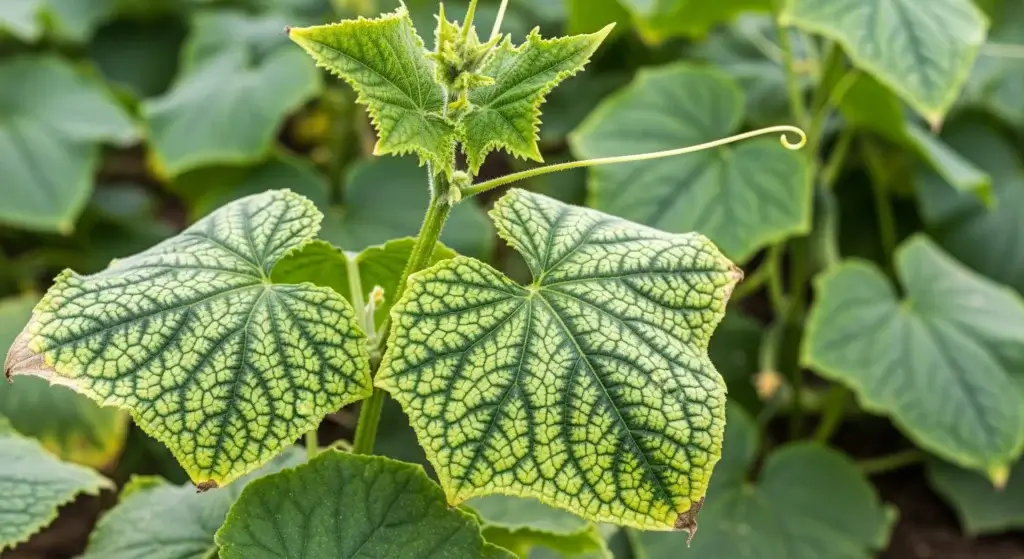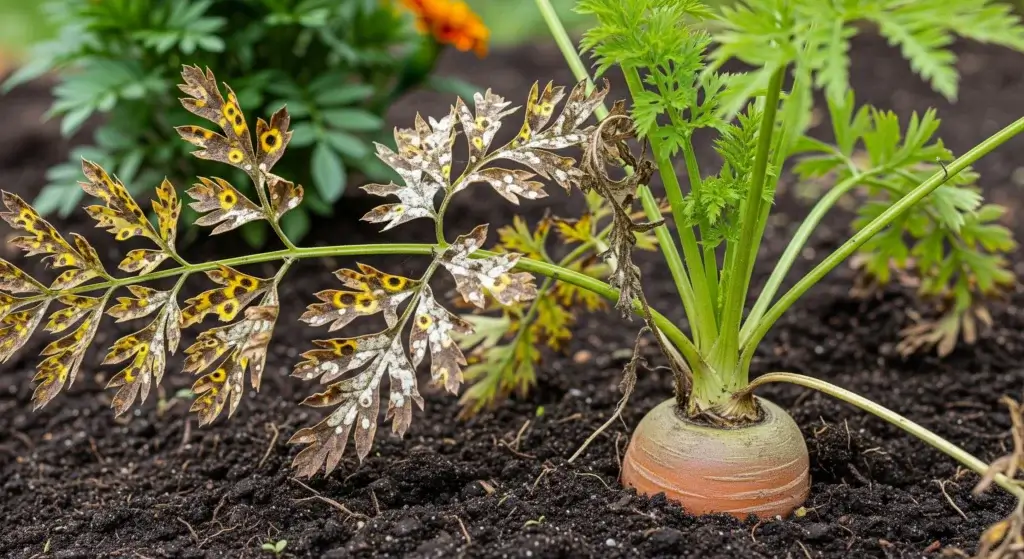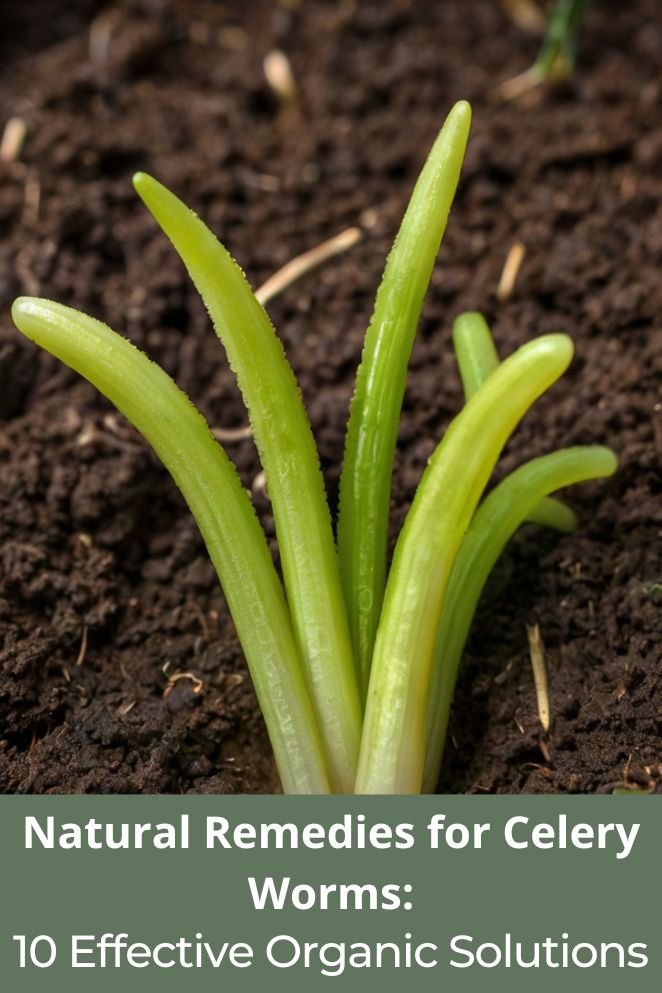
Finding green caterpillars chewing up your celery? You’re not alone.
They’re black swallowtail caterpillars—also called parsleyworms—and they can wreck your crop fast.
You don’t need to reach for pesticides right away.
There are natural ways to deal with them that won’t mess with your garden or the local ecosystem.
This guide covers simple, safe methods that actually work.
Understanding Celery Worms: Know Your Enemy
Before you deal with celery worms, it helps to know what you’re looking at.
These aren’t just random pests—they’re the caterpillar stage of the black swallowtail butterfly.
Nice to look at later, but rough on your plants right now.
Here’s how to spot them:
- Bright green with black bands
- Yellow or orange dots in the bands
- Smooth and chubby, about 2 inches long
- Usually hanging out on celery, parsley, dill, fennel, or carrots
They go after anything in the carrot family and can wipe out leaves fast.
Sure, they turn into pollinators later—but while they’re still caterpillars, they’re hungry and destructive.
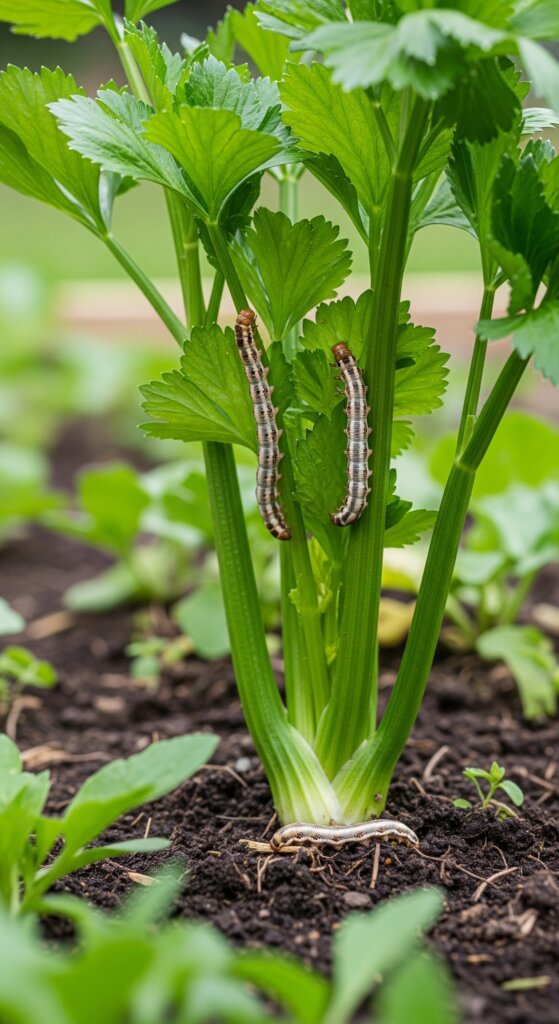
10 Proven Natural Remedies for Celery Worms
1. Hand-picking: The most direct approach
If you’re only seeing a few caterpillars, just pick them off. No gear needed.
Here’s what helps:
- Check your plants daily—early morning or evening’s easiest
- Look for chewed leaves and little black droppings (frass)
- Pull the caterpillars off gently and move them to wild fennel or parsley if you don’t want to kill them
- Use gloves if you’re not into handling bugs
Honestly, this works best when the numbers are low. If you’re catching them early, this might be all you need.
2. Bacillus Thuringiensis (Bt): Nature’s bacterial weapon
Bt (Bacillus thuringiensis) is a bacteria that only affects caterpillars.
It won’t hurt you, bees, or birds—but it will stop the worms from feeding.
Tips:
- Spray in the evening (sun breaks it down fast)
- Reapply after rain or watering
- Works best on smaller caterpillars—big ones take longer to stop eating
- Don’t skip the instructions—getting the mix right matters
It’s not instant, but it’s effective and pretty low-risk.
3. Neem oil: Multi-purpose plant protection
Neem oil messes with caterpillars’ hormones so they stop eating and eventually die off.
It won’t kill them right away, but it keeps things under control.
Here’s how to use it:
- Mix it exactly like the label says—too strong can burn plants
- Spray when it’s cool out (early morning or late evening)
- Cover all sides of the leaves, especially underneath
- Reapply every week or two, especially after rain
It’s also got antifungal benefits, and if you spray carefully, it won’t bother bees or other helpful bugs.
4. Companion planting: Strategic garden design
Some plants help keep pests away or draw in predators that eat them.
It won’t solve a big infestation, but it helps balance things long-term.
Try this:
- Basil: Smells strong and helps confuse pests
- Marigolds: Bring in bugs that hunt caterpillars
- Nasturtiums: Attract pests away from your celery
- Garlic/onions: Just make the area less inviting to soft-bodied bugs
Tuck these in around your celery. It’s not foolproof, but it gives you a head start.
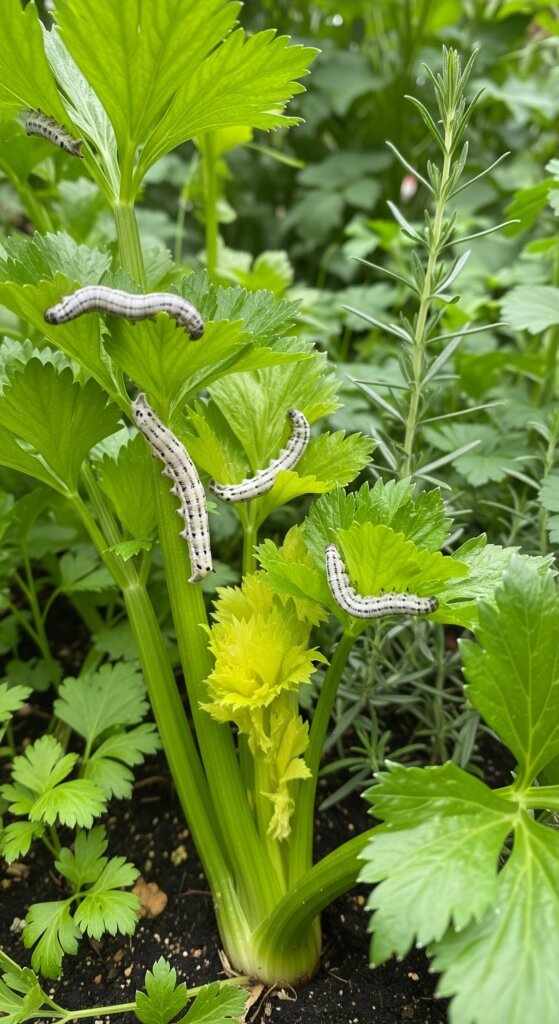
5. Beneficial insect attraction
If you give the right bugs and birds a reason to hang out, they’ll help control celery worms for you.
This is more of a long game, but it pays off.
What eats celery worms:
- Tiny parasitic wasps (they lay eggs inside the caterpillars)
- Birds like wrens and chickadees
- Spiders and beetles that hang out in low, leafy spots
How to bring them in:
- Plant a mix of flowers—different shapes and bloom times help
- Leave out shallow water dishes with rocks
- Don’t spray broad pesticides (they kill the good guys too)
- Add native plants and messy corners where bugs can hide
It takes time, but once the system sets up, you’ll notice fewer pest problems overall.
6. Diatomaceous earth: Microscopic protection
This is fossil dust that’s harmless to people but rough on soft-bodied bugs.
When caterpillars crawl over it, it cuts into them and dries them out.
How to use it right:
- Make sure it’s food-grade, not the stuff for pools
- Only apply when plants are dry
- Dust a light layer on leaves—don’t overdo it
- Reapply after rain
- Don’t use when flowers are blooming—it can hurt bees
It’s not a cure-all, but it’s helpful when you’re dealing with soft-bodied pests like caterpillars or slugs.
7. Soap spray solution: Simple and effective
Soap spray messes with caterpillars’ outer layer and breathing.
It doesn’t kill on contact, but it makes things uncomfortable enough that they stop eating and move on.
Here’s the mix:
- 1 tablespoon mild liquid soap (like Castile)
- 1 quart water
- Optional: 1 teaspoon veggie oil so it sticks better
How to use it:
- Test a small leaf first—some plants are sensitive
- Spray in the early morning or evening
- Coat the leaves, especially the undersides
- Rinse it off after a couple hours to avoid leaf burn
This won’t wipe out a big infestation, but it’s handy for small issues or in-between other treatments.
8. Essential oil deterrents
Some oils confuse pests and throw off how they find your plants.
It won’t kill caterpillars, but it can keep them from settling in.
What works best:
- Peppermint
- Rosemary
- Thyme
- Eucalyptus
Mix like this:
- 10–15 drops of essential oil
- 1 cup water
- 1 teaspoon mild soap to help it mix
Spray it weekly, especially after rain. It’s not bulletproof, but it can help keep caterpillars from showing up in the first place.
Just don’t expect it to fix a full-blown outbreak.
9. Row covers: Physical barriers
If butterflies can’t reach your plants, they can’t lay eggs—that’s where row covers come in.
It’s just lightweight fabric that keeps pests out but lets sun, air, and water in.
Why it works:
- Stops celery worms before they ever hatch
- Helps with other pests too
- Lasts for a few seasons if you store it right
How to use it:
- Put covers on before butterflies show up
- Pin the edges down tight so nothing sneaks in
- Take them off once your plants flower if they need pollinators
- Keep an eye on temps—plants can overheat under covers in hot weather
10. Timing and crop rotation
Butterflies lay eggs at certain times, and if your plants aren’t there when they’re looking, they move on.
What helps:
- Start celery early or late, not mid-season when butterflies peak
- Stagger plantings so pests can’t get comfy
- Pay attention to when black swallowtails usually show up in your area
And don’t plant the same stuff in the same place every year:
- It breaks up pest life cycles
- Helps with disease problems
- Gives your soil a break
- None of this is perfect on its own, but together it can seriously cut down on the damage.
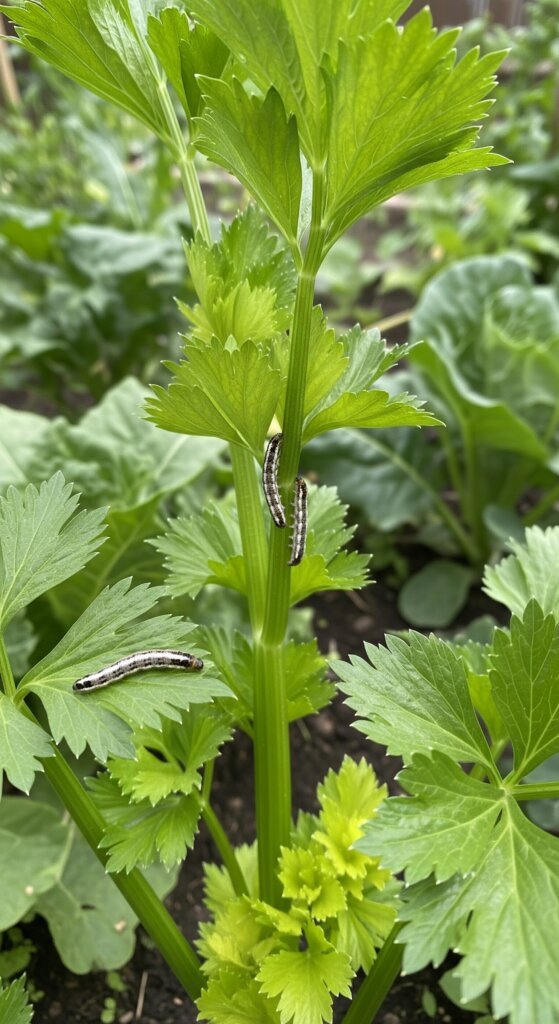
Prevention: The Best Defense
Regular monitoring and early detection
Once celery worms show up, you’re playing catch-up.
It’s way easier to stop them before they get going. Here’s what helps:
Check your plants every week
Keep it simple—just do a quick scan while you’re watering.
- Look under the leaves for eggs
- Watch for tiny holes or chewed edges
- Spot frass (caterpillar poop) early
- Remove anything suspicious before it spreads
Garden hygiene practices
Dead leaves and weedy corners attract pests. Try this:
- Clear out plant debris before it piles up
- Compost infected stuff hot, or toss it
- Wipe tools between plants if you’re moving around
- Pull weeds—especially anything in the carrot family
Soil health management
Strong plants fight off pests better.
- Add compost once a year
- Check pH now and then—celery likes 6.0–7.0
- Make sure the soil drains well
- Use mulch to lock in moisture and keep weeds down
No garden’s perfect, but a little prevention keeps most pest problems from turning into full-on disasters.
Integrated Pest Management Approach
No single trick fixes celery worms for good.
The best way to stay ahead is to stack your methods—what’s called integrated pest management (IPM).
It’s just using a mix of tools that cover different angles.
Here’s what that can look like:
- Cultural: Plant at the right time, don’t overcrowd, rotate your crops
- Biological: Attract birds, wasps, beetles—let nature do some of the work
- Physical: Pick worms off, use row covers, keep your space clean
- Organic sprays: Use Bt, neem, or soap when things start slipping
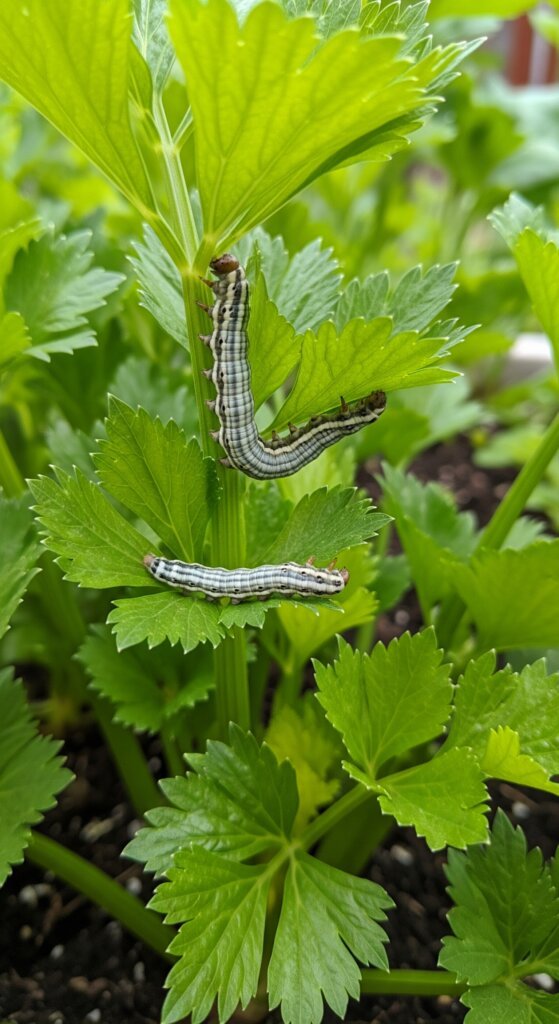
When to Seek Professional Help
Sometimes, even when you’re doing all the right stuff, it gets out of hand.
If that happens, don’t wait too long to call someone who knows pests inside out—especially if:
- Natural methods aren’t working after a few rounds
- It spreads to other plants fast
- You’re losing most of your crop
- You’re not sure what bug you’re even dealing with
There’s no shame in tagging in backup. The goal’s to save your garden—not win a purity contest.
Conclusion: Embracing Natural Garden Harmony
You don’t need chemicals to keep celery worms under control.
Hand-picking, bringing in good bugs, using sprays like Bt or neem, and planting smart all add up.
Pest control isn’t a one-and-done thing.
You’ve gotta stay on it—check your plants often, act early, and mix up your methods.
The goal isn’t to wipe everything out. It’s to keep a balance so your plants stay strong and your garden stays healthy.
Work with nature, not against it, and you’ll get better results in the long run.

